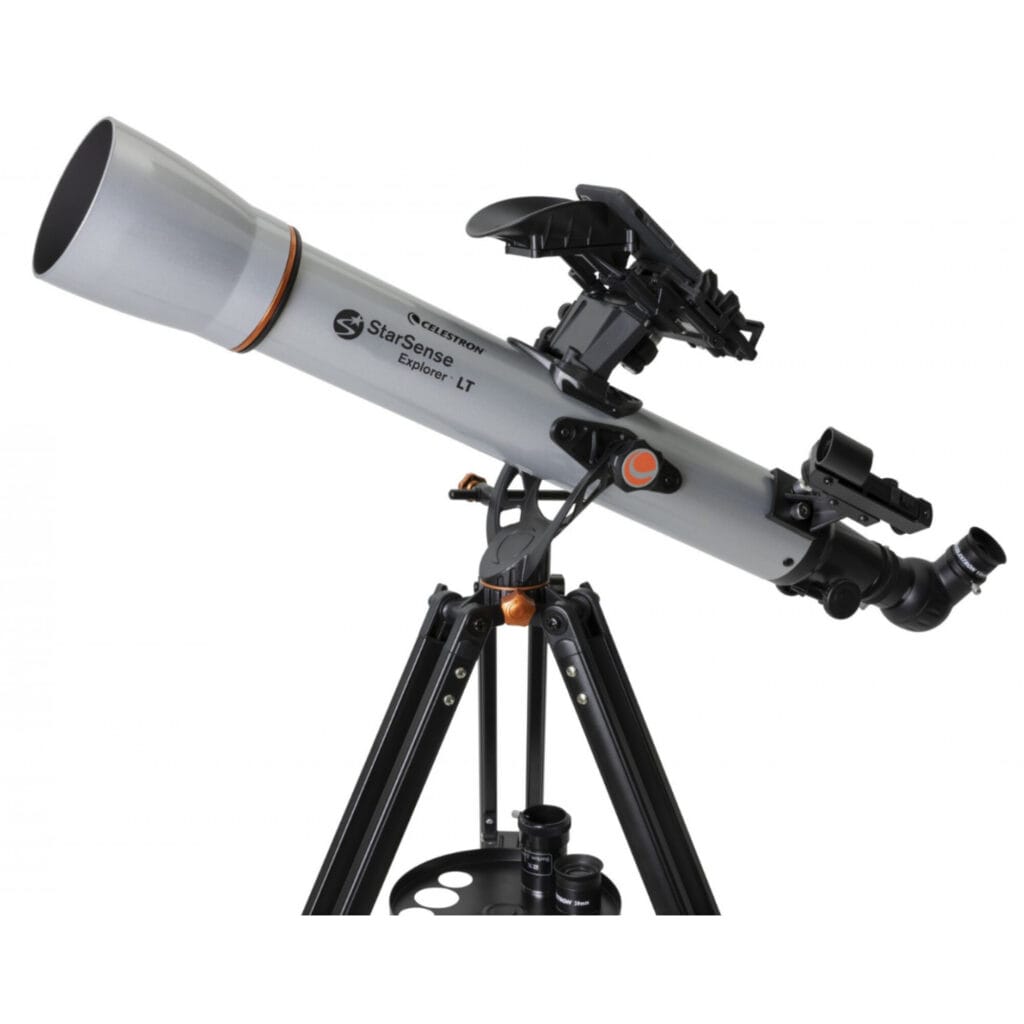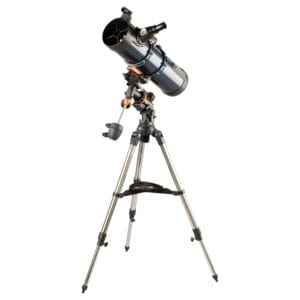The Celestron StarSense Explorer was developed to solve a well-known problem: finding objects in the night sky.
Many beginning observers find that aiming a telescope is the trickiest part of the hobby. Even in clear skies, it can be frustrating to get a planet or nebula precisely in focus.

Celestron has therefore designed a system that helps you without taking over the experience.
The StarSense Explorer combines traditional optics with smart software. You use your smartphone to recognize the sky while you manually move the telescope. The result is a simple, reliable way to see more in less time, without having to know anything about astronomy.
How the Celestron StarSense explorer system works.
On top of the telescope is a holder with a small mirror. You place your smartphone in it, open the StarSense Explorer app and point the telescope roughly toward the sky.
Your phone's camera looks at the sky through the mirror and recognizes star patterns.
Based on that, the app calculates where the telescope is pointed, without GPS or Internet connection.
An overview of the sky appears on the screen.
You choose an object, say Saturn or the Orion Nebula, and arrows on the screen indicate how to turn.
Once you are properly targeted, the app reports: “Object in visual field.”
You then simply look through the eyepiece, just like a traditional telescope.

The system works completely offline. Only your phone's sensors and camera are needed.
The Celestron StarSense explorer telescope itself
The StarSense Explorer is available in several versions.
They differ in optical design, weight and image character, but share the same construction quality.
- LT 70AZ / LT 80AZ: compact lens telescopes (refractors) for children and beginners.
- DX 102AZ: 102 mm refractor with higher light output and more stable tripod.
- DX 130AZ: 130 mm Newton reflector, with a wide angle of view and more detail reproduction.
The DX models offer a noticeably stiffer mount and better focusing mechanism than the LT variants.
The 130 mm version is particularly suitable for those who also want to see deep-sky objects, such as nebulae and star clusters.
The construction is simple but solid: aluminum tripod, fine adjustment screws and a smooth azimuth mechanism.
The whole thing weighs little, making the telescope easy to take with you to dark locations.
Image quality and performance Of the Celestron StarSense explorer
The StarSense Explorer's optics are similar to Celestron's AstroMaster series, but focused on ease of use.
Image quality is bright, with sufficient contrast for both moon and planets.
What to expect:
- The moon shows clear craters, shadows and mountain ranges.
- Jupiter shows its cloud bands and the four Galilean moons.
- Saturn shows the rings at magnifications from ±65×.
- Under dark sky conditions, the Orion Nebula (M42) visible as a haze with central star formation.
The DX 130AZ Performs best for general observation.
Thanks to its f/5 ratio (650 mm focal length, 130 mm mirror), it offers a wide field of view, ideal for objects with large apparent diameters.
The DX 102AZ has a slightly narrower field of view (f/10), which provides more contrast for moon and planets.
This telescope is designed for visual observation. Astrophotography is not the goal; the mount is too light for that.
Is the StarSense explorer good for beginners?
The StarSense Explorer is not a GoTo system with motors.
The telescope moves completely manually, but the app makes aiming efficient.
That means you stay in control, while the software helps guide you.
For many users, this is a pleasant balance:
you learn about the sky, but don't waste time on alignment or calculations.
Celestron itself calls this “manual assist,” and that describes it well.
Frame and controls
All models use a alt-azimuth mount (AZ).
It works in two directions: up/down and left/right.
It is the simplest and most intuitive way of moving, and excellent for visual observation.
An equatorial (EQ) mount would theoretically track more accurately, but requires alignment to the pole star and a better understanding of celestial coordinates.
For the target audience of this telescope, beginners and recreational observers, this is not necessary.
The movement of the StarSense Explorer AZ is smooth.
The friction is adjustable, allowing the telescope to maintain its position without tilting.
Strengths of the StarSense explorer
- Easy to use, even for absolute beginners.
- Good optical performance in its price range.
- App works reliably and completely offline.
- Quick to set up, light and portable.
- Promotes orientation and understanding of the night sky.
Restrictions of the StarSense explorer
- LT models have a lighter tripod and are more sensitive to vibration.
- No automatic tracking: objects move slowly out of focus at high magnification.
- Less suitable for long exposure photography.
- The app requires a smartphone with decent camera and gyro sensors.
But those who primarily want to observe visually and learn about the sky will be little bothered by this.
User Experience
What makes the StarSense Explorer special is its low barrier to success.
With traditional telescopes, the first hour often goes into searching; here you see results within minutes.
Users report being able to find multiple objects in one evening that they would never have recognized otherwise.
The system also promotes learning: after a few sessions, you automatically recognize constellations and positions in the sky.
The app does not take away the thinking, it speeds up the learning process.
Comparison with Celestron AstroMaster
Compared to the Celestron AstroMaster differs the StarSense Explorer especially in operation and ease of use.
The StarSense models use a alt-azimuth mount, which moves in height(altitude) and latitude(azimuth), while the AstroMaster is available with both equatorial (EQ) as AZ mounts.
Operating the StarSense is much simpler: you navigate using a smartphone app which recognizes the sky and indicates where to aim.
With the AstroMaster, that goes entirely manual, which requires more practice but also offers more control for those who want to learn. Fortunately, these days you do have apps like Stellarium that tell you which star or planet is where.
Qua user experience the difference is obvious.
The StarSense Explorer is designed for beginners and families Who want quick results and can get started without technical knowledge.
The AstroMaster, on the other hand, is intended for enthusiastic starters Who are willing to invest some time in learning how to work with a mount and coordinates.
What astrophotography Regarding: the StarSense Explorer is a purely visual telescope, not intended for long exposure times.
The AstroMaster offers a bit more potential, especially the EQ models can take short photos of the moon or planets, if equipped with a simple tracking motor.
In summary, the StarSense Explorer is the most intuitive choice for direct observing, while the AstroMaster is more suited to those who want to understand the technology behind observing.
For whom suitable
The StarSense Explorer is designed for:
- novice observers who want quick results,
- Families who want to explore the heavens together,
- schools and educational programs,
- Experienced observers seeking a second, lightweight telescope for spontaneous sessions.
Those with more control or photographic ambition can later switch to the Celestron NexStar or EdgeHD line.
Is the Celeston StarSense Explorer a good telescope? Our opinion!
The Celestron StarSense Explorer is not a revolutionary telescope, but a thoughtful tool that makes stargazing easier.
The optics are solid, the mounting stable enough, and the app works as promised.
It is an excellent starting point for beginners: you will see results quickly, learn the sky and develop confidence in using your instrument.
There is no better way to discover if this hobby suits you.
View full Celestron StarSense Explorer Series on Telescope.com
Expert advice and fast delivery.
- Rated 5.00 out of 5(0)
€ 699,00Original price was: € 699,00.€ 589,00Current price is: € 589,00. Add to cart - Rated 4.50 out of 5(0)
€ 399,00Original price was: € 399,00.€ 289,00Current price is: € 289,00. Add to cart













